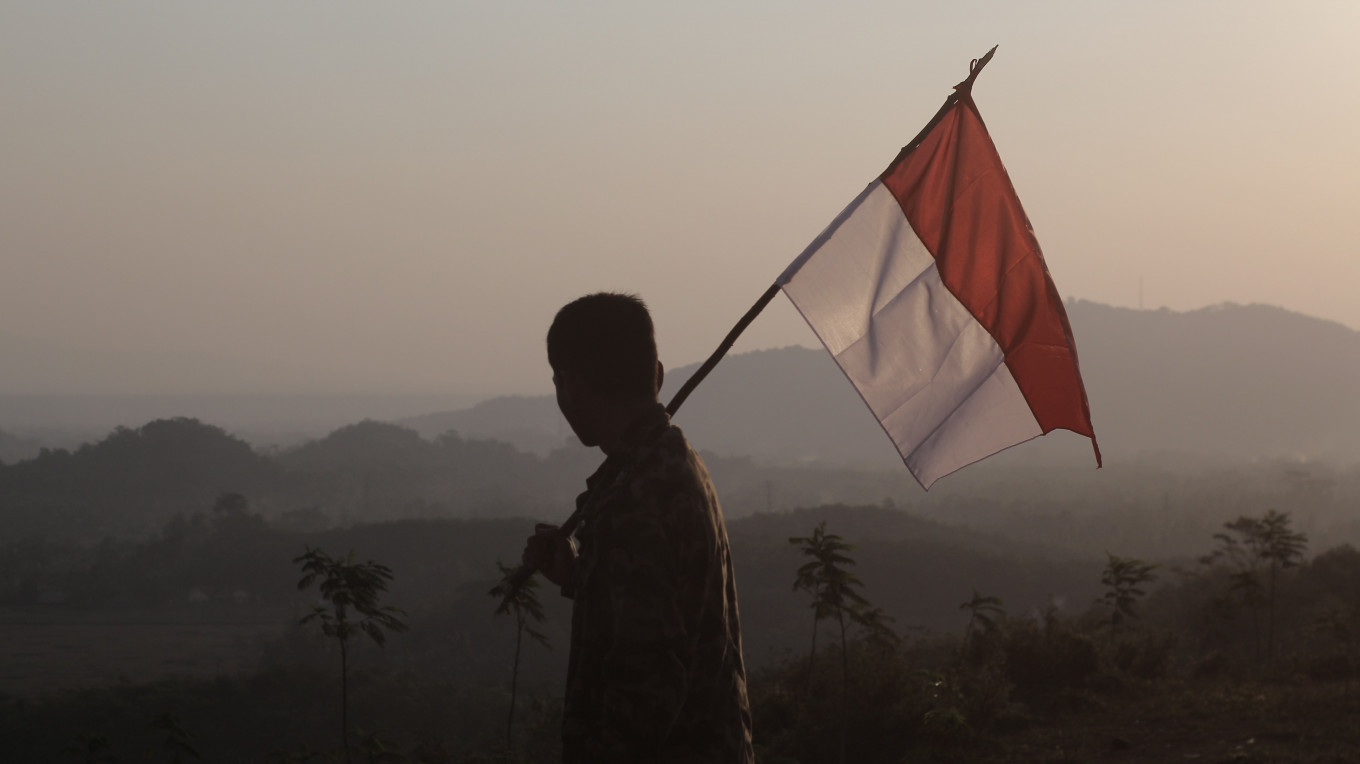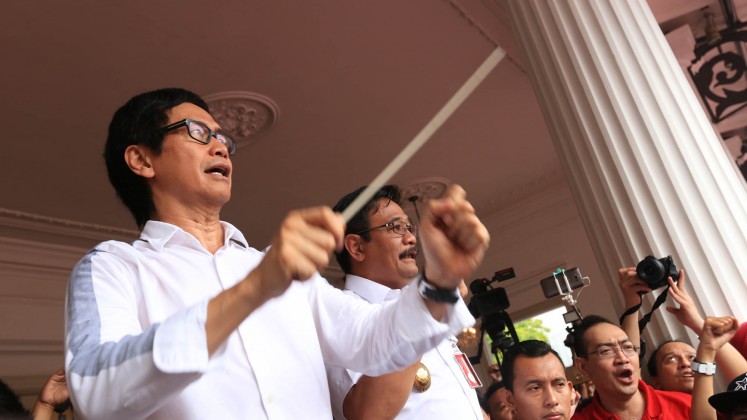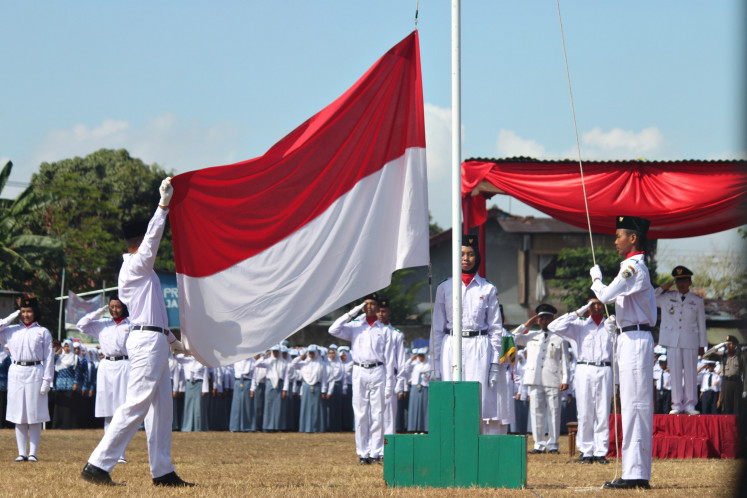Popular Reads
Top Results
Can't find what you're looking for?
View all search resultsPopular Reads
Top Results
Can't find what you're looking for?
View all search resultsIndonesian Icons: The enduring power of ‘Indonesia Raya’
Famed composer Addie M.S. takes us on an insightful journey through the compositional and historical origins of our national anthem and why it still evokes such powerful emotions.
Change text size
Gift Premium Articles
to Anyone
T
he “Indonesian icons" series offers an in-depth look at the elements and events that have shaped the country and defined national identity, from noteworthy people, culinary delights and historic locales to unforgettable moments.
It was only two weeks ago that Greysia Polii and Apriyani Rahayu made history by winning Indonesia’s first gold medal in the badminton women’s doubles at Tokyo 2020. As the duo stood atop the medal podium saluting the “Red and White”, the Indonesian national anthem burst forth from the stadium speakers.
At that particular moment, our Olympian shuttlers couldn’t hold back their tears, probably much like the many thousands of their fellow countryment watching them from home. Nearing two years of unending challenges and nationwide grief, the song provided a brief glimpse of hope, reinforcing our innate connection to our homeland.
Indiana Basitha, a 34-year-old employee at a pharmaceutical company, said she got “chills and goose bumps” when she heard “Indonesia Raya” play as Greysia and Apriyani stood with their gold medals and bouquets during the ceremony, their eyes clearly brimming with emotion behind their red-and-white masks.
Read also: Indonesian Icons: Susy Susanti – the first Indonesian Olympic gold medalist
“For a moment, we all forgot about the noise surrounding COVID-19. We could immerse in the feeling of celebrating something together,” said Indiana.
It was a callback to 29 years ago, when badminton queen Susi Susanti was similarly overwhelmed as she received the country's first ever Olympic gold at Barcelona 1992, to the familiar yet moving tunes of “Indonesia Raya”. That photograph remains one of the country’s most iconic, while that moment encapsulates one of the country’s most triumphant.
And it’s not just in the sports arena.
Local metal act Seringai, the opener for Metallica during the American heavy metal legend’s 2013 Asia Tour, raised the curtain – and the audience – with pop singer Raisa’s a cappella rendition of “Indonesia Raya”. As she sang, the 10,000 or so metalheads at Gelora Bung Karno Stadium jumped to their feet as one, hand on chest, and sang their hearts out, many to the point of tears. The band remembers getting shivers in that moment, the same as anyone else who was there.
The power that song holds is hard to explain; rather, it is felt in the bones. Even though it is played and performed almost routinely at events, and often in the early mornings at elementary schools and offices to sleepy eyes and wandering minds, it retains an emotionality that rarely fails to rouse even the most jaded of citizens.
Read also: Guiding students toward independence
What is it about “Indonesia Raya” that evokes such overwhelming emotion? Are Indonesians simply wired to be moved by the song at birth?
Optimistic and direct
Legendary composer and conductor Addie Muljadi Sumaatmadja, better known as Addie M.S., offered his musical analysis of “Indonesia Raya” during a Zoom interview with The Jakarta Post on Aug. 14: The Indonesian national anthem is uniquely memorable for its directness.
“Many other national anthems have to be heard more than once before it starts to register in your brain, but ‘Indonesia Raya’ is really strong due to its uplifting, optimistic melody,” Addie said. “A national anthem should be easy for the people to remember.”
“The [lines] ‘tanah tumpah darahku’ [the land where my blood is spilled] and ‘jadi pandu ibuku’ [as a standard of my motherland] are my favorite parts because the melody goes down, which normally would suggest a [falling] emotion, but because of the melody of the previous section, it just sounds so open and powerful, thanks to the quarter notes and the percussion,” he said.
Addie also mentioned that Indonesia’s founding president, Soekarno, was involved in the musical arrangement of “Indonesia Raya”.
“During the pre-chorus or bridge, it turns soft. While the previous part is tutti [all instruments playing], Soekarno wanted the bridge to be calmer and more textured, less monotonous so that when it hits the chorus, it soars,” he explained.
“During the bridge, you only have one main melodic line played by the violin and the clarinet, and then when the chorus comes, everyone else joins in, the timpani, etc., and you get this thunderous sound.”
A ritardando draws the anthem to a close as it gradually decreases in tempo, a compositional design that gives the song a sense of finality and grandeur, according to Addie.
“It’s just more natural and organic, like when you ride a bike or when a train goes by, they don’t stop just like that. There’s a process of slowing down, it resembles that, and it’s just an artistic decision,” he said. “Often, a composer will indicate how much ritardando he wants by writing it on the sheet music.”
Long road to remastering
Written by Wage Rudolf Supratman in 1928, “Indonesia Raya” was first recorded in 1950, in a performance by Dutch composer Jos Cleber and the resident symphony orchestra of Republic of Indonesia Radio (RRI). It became the official recording, used by RRI and the government for almost 50 years.
In the 1990s, whenever “Indonesia Raya” was played by national broadcasters like TVRI, Addie would get annoyed because of the substandard audio quality, with crackles and pops.
“Back then, the technology was not as sophisticated yet. Even the master recording was noisy, so every time it was reproduced and duplicated from vinyl to tape, the noise got worse and worse,” Addie said.
In 1995, during the 50th anniversary of Indonesian independence, Addie and the Twilite Orchestra he cofounded were invited to perform at Merdeka Palace and Bogor Palace. During the occasion, he mentioned his idea of remastering “Indonesia Raya” to Titiek Soeharto, the second daughter of then-president Soeharto. She was on board with the idea and introduced him to then-state secretary Moerdiono.
Read also: Growing together in communities makes Indonesia more powerful
Addie received government funding to record two other iconic nationalist compositions along with the national anthem: “Bagimu Negeri” (For you, my country) and “Mengheningkan Cipta” (Moment of silence). When the recordings were done, strangely enough, the government didn’t seem to care. There was no formal handover of the recordings, so Addie simply filed them in his personal archives.
In 1997, Youk Tanzil, a Chinese-Indonesian businessman who owned a multimedia company, was looking for a copy of “Indonesia Raya'' for business purposes and approached Addie. The composer explained the issue with the existing recordings and persuaded Youk to help him record a new master of the national anthem.
With funding from a handful of big companies and business leaders, including Tjahjono Soerjodibroto, who was the PT Indosat president at the time, and Peter Gontha, then head of national broadcaster SCTV, “Indonesia Raya” was given new life.
“Indonesia Raya” was remastered at Allan Eaton Studio in Melbourne, Australia, performed by Twilite Orchestra alongside the Victorian Philharmonic Orchestra and the Melbourne Symphony Orchestra.
Addie ended up recording nine other nationalist songs as well, among them “Bagimu Negeri” by Kusbini, “Hari Merdeka” (Independence day) by H.S. Mutahar and “Rayuan Pulau Kelapa” (Coconut island seduction) by Ismail Marzuki.
As the recording sessions ended, Youk left the studio, crying. Addie said he couldn’t forget Youk’s reply when he asked what was wrong.
“‘I can’t handle it, I’m of Chinese descent, and yet I am [still] able to do something for my country and nation,’” Addie quoted from memory.
The songs were released on CD and cassette tape in October 1998 as one album, Simfoni Negeriku (My country’s symphony), and distributed for free to TV and radio stations, schools, government institutions, the military and others.
It is this recording of “Indonesia Raya”, made just six years after a Chinese-Indonesian athlete brought home the country’s first Olympic gold medal from another foreign land, that has been blaring out from our speakers for the past 24 years.
Which version?
Before the remastering session, Addie had to learn the sheet music for “Indonesia Raya” that was appended to Government Regulation (PP) No. 44/1958 on Indonesia’s national symbols, while making sure he adhered to the PP’s provisions. The regulation was later upgraded and enshrined as Law (UU) No. 24/2009 on the national flag, language, emblem and anthem.
Guts and glory: The national anthem is a fixture at schools and even offices, and is played compulsorily at official and ceremonial events, like this flag-raising ceremony. (Unsplash/Courtesy of Unsplash/Mufid Majnun)It was then that Addie found a discrepancy between the sheet music, which may not be altered according to the PP, and the RRI’s master recording of “Indonesia Raya”.
“The two were definitely arranged by different people,” he revealed.
Apparently in 1952, Raden Adrianus Josephus Soedjasmin, who led the National Police Music Corps, went to RRI founder Jusuf Ronodipuro with the idea of rearranging “Indonesia Raya” so it would be 100 percent Indonesian, since the song’s original arranger Cleber was Dutch.
According to Addie, Soedjasmin’s arrangement is a simplified version of Cleber’s, especially the trumpet part in the chorus.
President Soekarno didn’t like the new version, however, and it is said he got angry and actually tried to break the master recording, so it’s a mystery why the sheet music for the Soedjasmin arrangement was appended to PP No. 44/1958 and not the Cleber arrangement.
As the late Bondan Winarno speculates in his book, Lagu Kebangsaan Indonesia Raya (The national anthem, “Indonesia Raya”; 2003), for which Addie M.S. is also listed as an interviewee, there may have been an attempt to minimize Cleber’s role because of his nationality.
A year before Cleber died in 1998, Bondan interviewed him in Hilversum, the Netherlands. The Dutch composer had apparently rejected previous interview requests, because he wanted to bury the controversy that had led to him being unrecognized for his work on “Indonesia Raya”, which remained a source of bitterness.
Read also: Indonesian Icons: Tempeh the superfood and a link to Indonesia's past
Addie lamented that Indonesians were essentially taught how to regard the national anthem, equating the general stance to how Indonesians regarded pop songs: as mere entertainment instead of a source of learning and a work of art.
He also compared Indonesia’s approach to how Japan, China and European countries took a more serious stance in educating their citizens on the compositional and historical values of their national anthems. This was why, the composer explained, the anthem was often performed with low, swaying energy, when it should actually be performed vigorously as noted on the sheet music.
So for his remastering of “Indonesia Raya”, Addie decided to go with Cleber’s arrangement instead.
“Had I gone with the official [Soedjasmin arrangement], I would have been fine, but I’m sorry, I don’t think it’s very good. I took a chance and if I get blamed for it, then cuff me,” he said.













